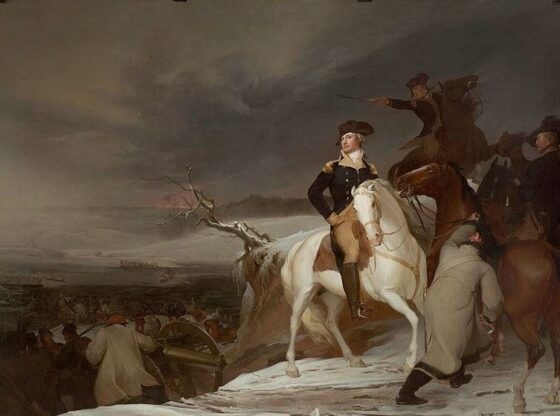Newspaper publisher Thomas Greene of New Haven, Connecticut, had already started printing his 1 January 1777 issue of the Connecticut Journal when he received an express letter from New Jersey or Pennsylvania about an event that took place on 26 December 1776. Filled with relief at finally receiving good news after months of losses by the Continental Army in New York, Greene wanted to immediately notify his readers.
He removed a portion of one of his articles on page two. He then typeset a new block and inserted an extract from the letter he’d received, leaving the other article dangling and incomplete. What news was so powerful and encouraging that Greene had to share it right away?
Greene reported the news contained in the express letter:
“That early on the 26th of December General Washington with about 3,000 men crossed the Delaware [River], and at 8 o’clock in the morning engaged the enemy at Trenton, who were about 1,600 in number, and in 35 minutes routed the whole, taking 919 prisoners, exclusive of killed and wounded.”
Washington’s men had attacked the British position at Trenton, New Jersey, which was held by Hessians (German troops hired by the British). Expecting them to have been drinking and enjoying the Christmas holiday, Washington tapped the element of surprise and caught the enemy both off guard and inebriated. Greene’s article listed the number of officers and soldiers captured by rank, along with pieces of artillery and ammunition.
Receiving a letter from an officer in the American army in Newtown, Pennsylvania, Greene published additional details seven days later. The newest letter said:
“I have the pleasure of giving you an account of an advantageous victory obtained over the Hessians yesterday… Something was necessary to check the progress of the enemy; it was therefore resolved by his Excellency [George Washington] to attack the Hessian army at Trenton; for which purpose everything was in readiness.”
This officer provided another first draft of history from this momentous event:
“And on Christmas night we marched down to the river with upwards of 2,000 men and 12 pieces of artillery, at McConkey’s ferry, Delaware river, and at half after 3 o’clock began our march to Trenton.”
Emotions followed facts:
“A colder or icier season I never felt. Rain and hail, with high winds – but no difficulties were too much for our worthy commander to surmount at this important crisis.”
The officers had divided their men into columns and began their attack at eight in the morning:
“His Excellency commanded in person, and in about three quarters of an hour they surrendered.”
He then described the treacherous conditions of the river, which artists later brought to life in now-famous paintings:
“We intended the attack should have been before daylight but the fatigue of marching and trouble of crossing the Delaware detained us.”
The Hessians had been preparing for a retreat but took their time because “the extremity of the weather made them conclude we were not coming (as they had information) and so all turned in, and thought themselves quite secure.”
This officer also praised his fellow soldiers and General Washington:
“Too much praise cannot be given to our brave troops. His Excellency was pleased at their undoubted courage; not a soul was found cowardly skulking, but was fierce for the battle.”
Journalism is the first draft of history. Centuries later, thanks to collections of old newspapers such as GenealogyBank’s Historical Newspaper Archives, readers can rediscover stories like these from people who witnessed major events.


